Secrets of growing and caring for carrots outdoors for a good harvest
Carrots are a rather finicky vegetable that is able to respond to unaccounted for nuances in the process of growing with a strange harvest and a disappointingly low harvest. Caring for carrots in the open field implies a strict sequence in each of the points of the successive stages of the development of the root crop, and to miss any of the points means to jeopardize all the work spent. How to care for carrots correctly?
What should be a bed for carrots
How to properly grow carrots? A high yield begins with the preparation of the soil for planting, and the initial preparations need to be carried out in the fall. On the garden bed, a level place is chosen, sufficiently illuminated by the sun during daylight hours and, preferably, used previously for planting cucumbers, white cabbage or cereals. Depending on what kind of soil the carrots like, namely, neutral or slightly acidic, the alkaline balance of the soil is regulated.
To begin with, it is required to assess whether the soil is suitable for carrots for this indicator. The easiest way is to collect a pinch of earth from the desired area on a piece of clean glass and pour over it with table vinegar. An alkaline and weakly acidic environment will react with a strong or moderate foam (as when quenching soda), and an acidic one will not show any changes.
You can also pay attention to the clogging of the site with grass:
- neutral soils are rich in lush long vegetation: stinging nettle, quinoa, clover;
- acidic soils, on which it is impossible to grow sweet carrots, will abound in mint, horsetail, violet and buttercup;
- on the soil with weak acidity, burdocks, alfalfa, small pharmacy chamomile and sow thistle will be found;
- an alkaline environment, the poorest and also not very suitable for growing carrots in the open field as an acidic one, it is characterized by: poppy, sweet clover, bindweed.

The second task in the question of how to grow a good harvest of carrots is to create conditions for saturating the soil with oxygen. This is required so that the carrot tastes sweet and grows slenderly in length, and does not go horny to croak in all directions, bumping into the firmament of not loosened earth. A clumsy carrot occurs when a vegetable begins to branch out in search of a convenient direction and softer soil, and not sweet due to lack of air.
Light fluffy soil, not clogged with clay, is enough to work out with a garden rake, and hard, packed layers must be completely broken by deep digging.
How to plant carrots correctly
How to grow carrots in even rows and evenly distributed along the groove? In order to get a good harvest, vegetables should not sit tightly to each other, which means that a distance between the seeds should be observed, which is convenient for thinning later. There are many such convenient ways in agricultural technology:
- with a mixture of flour and water, to a strip from a paper towel or napkin, the seeds are glued at a distance of 2-3 cm from each other, then these tapes are inserted directly into the grooves after pre-planting watering;
- combine the contents of a bag of seeds with 1 glass of clean sand, mix everything and introduce this mass in a thin stream into the dug groove;
- in a liter of water, two tablespoons of starch are boiled and this barely warm substance, with seeds added to it, is poured into the prepared grooves;
- Most gardeners, when planting this crop, traditionally put seeds into the soil with a distance of about 4 cm and a gap between rows of 15 cm.
What to do right after landing? The bed is covered with polyethylene, which is held until the first shoots appear. The vegetable tolerates low temperatures and even soil frosts quite tolerably, but prolonged cold weather is the reason why carrots go to the arrow to the detriment of root development.
Watering carrots
Outdoor carrots do not require as much regular as uniform watering - the plant does not care how often the soil is moistened, but the moisture level should be constant and unchanged. Deviation from the level of saturation with water in the soil, which is comfortable for the root crop, leads to pathologies of root formation:
- superficial and slight soil moisture leads to the formation of a stiff rhizome - the pale core of such a vegetable tastes bitter, and the carrot itself sometimes grows to bulky, shapeless balls;
- when growing carrots, it is also dangerous to oversaturate the soil with watering - there is a risk of getting nondescript twisted freaks with branched tops.
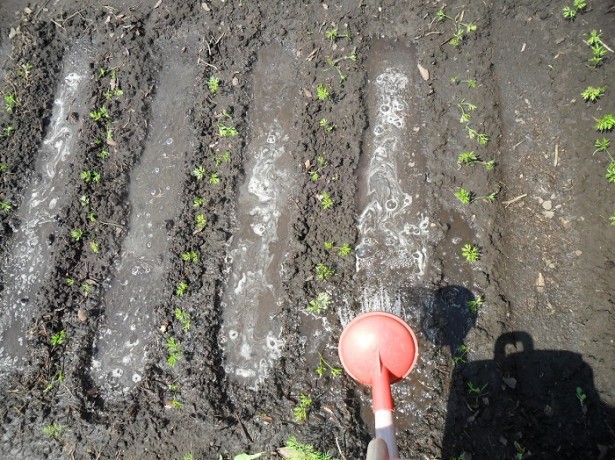
One of the signs of improper and uneven watering is a horned carrot with two or more root forks. To avoid mistakes of this kind, it is better to water the root crops, adhering to the approximate scheme:
- when the first shoots appear, 7-8 waterings are carried out during the month, 6 liters of water per 1 m2 plot;
- in the first month of summer, the rate increases to 11-12 liters, multiplied by 5-6 waterings;
- in July, waterings should be only about five, but 13-15 liters per square meter;
- the onset of August entails a decrease in water consumption and labor costs - carrots are growing already on two irrigations of 6 liters of water each.
Watering is stopped 14-20 days before the day scheduled for harvesting. Then a one-time moistening of the soil is carried out to facilitate the digging process.
Weeding and thinning carrots
Growing carrots in the open field should be accompanied by repeated weeding, especially in the period before germination, when weeds with powerful rhizomes may not allow a vegetable crop to emerge. Weeds should not be allowed to grow too tall - late weeding is one of the reasons why gardeners subsequently miss a useful crop, because along with the grass, the young tops of the never-grown vegetable appear in the common heap.
How to get high yields with regular weeding? There are two theories, equally substantiated by the experience of gardeners, of how to weed a vegetable:
- after watering or rain - thus, the weeds are easily pulled out with the entire root system;
- before watering, when the ground is dry, thin grass roots in this case remain in the ground and dry out, which prevents the germination of new weeds.
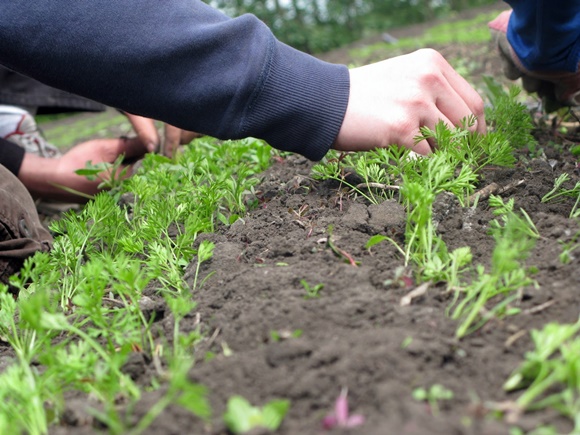
Another obligatory procedure, without which the cultivation and care of this crop in the open field is impossible, is the competent thinning of plants in the garden. When the seeds are initially planted at the same distance from each other of 2-3 cm, thinning is a procedure, rather, corrective and not always necessary. Continuous sowing in any of the ways, when the seeds went into the furrow chaotically, in the long term always means one or two stages of breaking through the excess growth. Do I need to do this? Required. The first thinning is carried out immediately, as soon as individual leaf bushes can be distinguished by the emerging greenery.
Often the answer to the question: why do carrots grow ugly lies precisely in the wrong actions when removing excess sprouts.
There are certain secrets of how to correctly perform this simple operation.
What to do and in what sequence to perform actions:
- before thinning, the beds must be shed abundantly from the garden watering can;
- the sprout should not be pulled, but pulled out of the ground strictly upward, without swinging it;
- it is necessary that there is a distance of 3 or 4 cm between the saved bushes;
- immediately after the procedure, the garden is watered with warm water.
At the same stage, it is customary to carry out the first hilling of carrots and the first loosening between the rows. And, if the second part of the algorithm does not raise big questions, there is a lot of controversy about the first one.
So - do you need to huddle carrots?
We huddle correctly
Often, even from experienced gardeners, you can hear that carrots are not hilled. However, if you are not too lazy to do this painstaking work at least three times during the development of the vegetable, you can secure the future harvest from three misfortunes at once:
- from damage to the open part of the root by a carrot fly, which likes to lay eggs at the base of the vegetable;
- from the protrusion of greening at the top of the rhizome;
- from exposure to direct sunlight, which leave burns on the root surface near the tops.
Since it is recommended to huddle the root crop three times, the procedures are tied to certain phases: on the 5th, 7th and 10th leaves released.
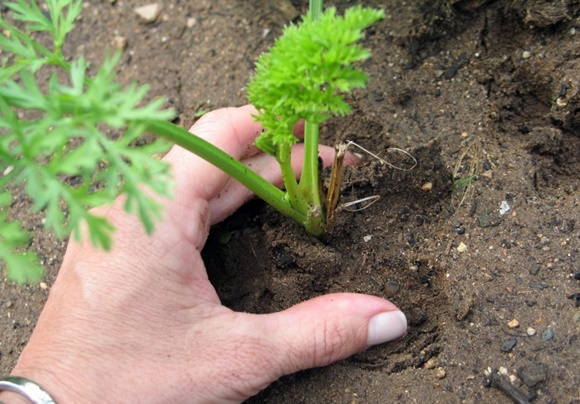
Mulching a vegetable
How to grow large carrots and at the same time deliberately exclude the risk of overdrying the soil, the danger of pests, and also significantly reduce the number of weeding and loosening? For this, there is a technology for covering the soil with mulch, and the technique itself is called "mulching".
How to mulch a carrot bed? The most common way to mulch a garden bed is to cover the space between the rows of planted vegetables with hay, straw chops or sawdust. The latter option is preferable, since the shelter with sawdust retains moisture longer and is a more reliable shield against the invasion of cabbage and other pests.
Sawdust covering the soil has another important advantage over grass mat - weeds do not germinate through it, while the dried grass itself may by default have mature and ready-to-germinate seeds that will grow on contact with moisture. Small chips, along with sawdust, have the same properties.

It is recommended to mulch the carrots when the outer part of the plant reaches 14-16 cm, and the vegetable itself will be about 7-8 cm in diameter at the widest part of the root. Can late varieties be mulched? It is not only possible, but also necessary, since the shelter retains the temperature for a long time, which it receives from the sun in the daytime, and as a result, the roots are juicy and not cracked.
On the forums, there are often complaints like the following: "I mulch a vegetable crop according to all the rules, but the vegetable withers, the tops fall, and the result is a horned or otherwise ugly carrot that has no sweetness." An important condition before the procedure is material drying. No matter what mulching is done, the cover should not flush and thus serve as a habitat for the reproduction of harmful microorganisms.And the secret of withering, falling tops is rotting of the root, to which oxygen does not reach through the dense crust of raw mulch. These are all the secrets of proper mulching.
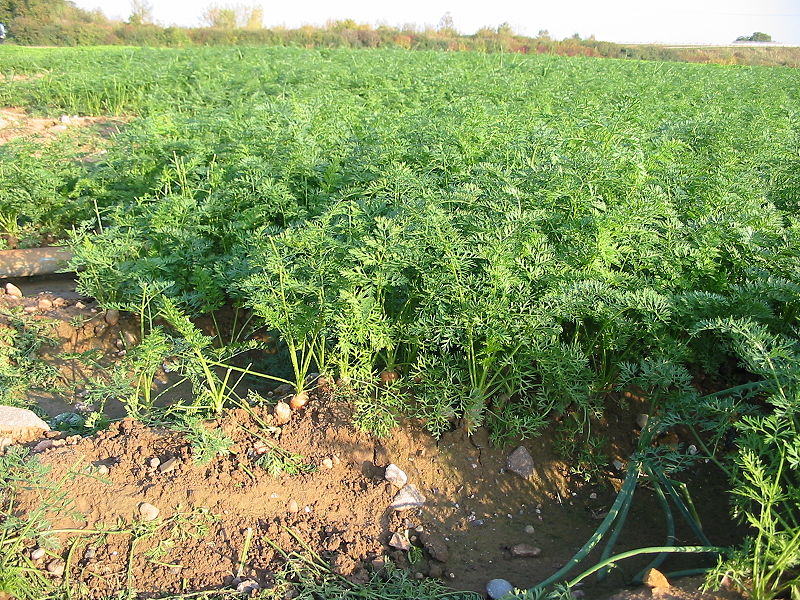
Typical mistakes
Let's name the most common mistakes gardeners make, which answer the most frequent complaints about why carrots don't grow:
- the seeds were planted without presoaking or in insufficiently heated soil (the norm is 7-9 FROM);
- too deep sowing or improper formation of the groove (it is supposed to deepen the groove by 2 cm, then tamp its bottom with the edge of the palm or the handle of a hoe);
- no watering before or after planting, or watering with cold water;
- abundant watering of the soil during the time until the sprouts are hatched out of the soil (until the green brush of the sprouted plants appears on the garden bed, you cannot water the garden);
- frequent watering with a small amount of water, in which moisture does not penetrate deep enough;
Why does carrot grow poorly? Perhaps due to the lack of a feeding element throughout the development of the plant. In not rested or depleted soil, vegetables will be thin, pale, covered with white hairs. A lack of potassium will immediately affect the density of the root - it will become woody, and the lack of phosphorus will affect the taste - the carrot will become tasteless or even sour.

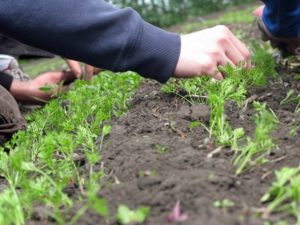








I often had problems with carrots, they need to be constantly fed, as well as to regulate watering. I use as a top dressing BioGrow... An excellent tool, thanks to him the harvest is good.